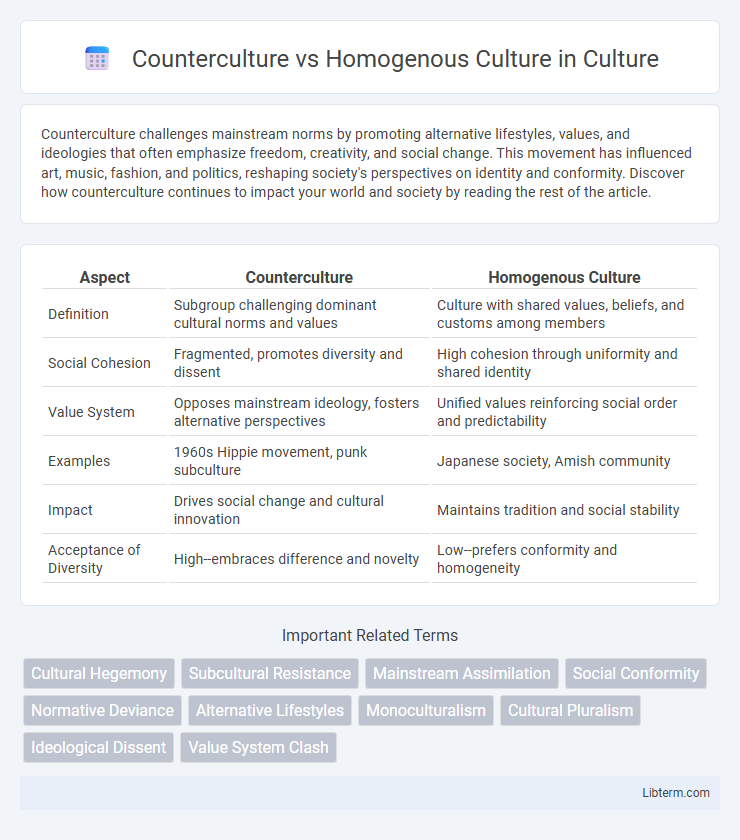Counterculture challenges mainstream norms by promoting alternative lifestyles, values, and ideologies that often emphasize freedom, creativity, and social change. This movement has influenced art, music, fashion, and politics, reshaping society's perspectives on identity and conformity. Discover how counterculture continues to impact your world and society by reading the rest of the article.
Table of Comparison
| Aspect | Counterculture | Homogenous Culture |
|---|---|---|
| Definition | Subgroup challenging dominant cultural norms and values | Culture with shared values, beliefs, and customs among members |
| Social Cohesion | Fragmented, promotes diversity and dissent | High cohesion through uniformity and shared identity |
| Value System | Opposes mainstream ideology, fosters alternative perspectives | Unified values reinforcing social order and predictability |
| Examples | 1960s Hippie movement, punk subculture | Japanese society, Amish community |
| Impact | Drives social change and cultural innovation | Maintains tradition and social stability |
| Acceptance of Diversity | High--embraces difference and novelty | Low--prefers conformity and homogeneity |
Understanding Counterculture: A Brief Overview
Counterculture represents a social group that actively rejects and challenges dominant societal norms and values, contrasting sharply with homogenous culture, which emphasizes uniformity and shared beliefs within a community. Key characteristics of counterculture include dissent, alternative lifestyles, and innovative ideologies aimed at societal transformation. Understanding counterculture involves analyzing its role in promoting social change and highlighting tensions within a seemingly unified society.
Defining Homogenous Culture in Modern Societies
Homogenous culture in modern societies refers to communities where shared beliefs, values, customs, and language create a unified social identity that minimizes internal diversity. This cultural uniformity often results from historical traditions, education systems, and media that promote common norms and collective behavior. Such cohesion can enhance social stability and mutual understanding but may also suppress individual differences and discourage alternative viewpoints.
Historical Roots of Countercultural Movements
Countercultural movements historically emerged as reactions against homogenous cultures characterized by uniform social norms and dominant ideologies. Key examples include the 1960s Beat Generation and the Hippie movement, which challenged mainstream values through alternative lifestyles, anti-establishment beliefs, and artistic expression. These movements drew on socio-political upheavals such as the Civil Rights Movement and opposition to the Vietnam War, highlighting deep-rooted dissent in rigid, conformist societies.
Key Characteristics of Counterculture
Counterculture is characterized by its deliberate opposition to mainstream societal norms, values, and practices, often advocating alternative lifestyles and beliefs. It embraces diversity, challenges established authority, and promotes social change through unique expressions in art, music, and political activism. This cultural phenomenon fosters community among marginalized groups, emphasizing individuality and resistance against homogenized cultural expectations.
Traits and Dynamics of Homogenous Cultures
Homogenous cultures exhibit traits such as shared language, values, and customs that foster strong social cohesion and uniformity in behavior. These cultures emphasize conformity, tradition, and collective identity, which reduce internal conflict and promote stability. The dynamics of homogenous cultures often involve limited diversity, slower social change, and a preference for maintaining established norms and practices.
Social Impact: Counterculture vs Homogenous Culture
Counterculture movements drive social innovation by challenging prevailing norms and promoting diversity, often sparking significant cultural shifts and policy reforms. In contrast, homogenous cultures tend to maintain social cohesion and stability through shared values and traditions, but they may resist change and marginalize dissenting views. The tension between these cultural dynamics shapes societal progress and influences the inclusivity of social systems.
Resistance, Rebellion, and Cultural Shifts
Counterculture emerges as a form of resistance against homogenous culture by challenging dominant social norms and values, often sparking significant cultural shifts through rebellion and alternative lifestyles. This opposition manifests in movements that reject mainstream conformity and advocate for diverse identities, ideologies, and practices. The tension between counterculture and homogenous culture drives transformative changes in art, politics, and societal attitudes, reshaping collective cultural narratives.
Media Representation and Cultural Perception
Media representation of counterculture often challenges the dominant narratives presented by homogenous culture, highlighting alternative values, lifestyles, and resistance to mainstream norms. Homogenous culture typically promotes uniformity and reinforces dominant ideologies through mass media, shaping cultural perception by marginalizing dissenting voices and reducing diversity in representation. This dynamic influences public understanding by framing countercultural movements as oppositional or deviant, while homogenous culture maintains social cohesion through consistent and widespread media portrayals.
Case Studies: Counterculture and Homogenization
Case studies on counterculture, such as the 1960s Hippie movement in the United States, reveal how alternative lifestyles challenged mainstream norms and promoted values like peace, environmentalism, and personal freedom. In contrast, homogenization is evident in globalized urban centers where cultural expressions become standardized, often driven by multinational corporations and mass media, diminishing local diversity. These case studies highlight the tension between preserving unique cultural identities and the pressures of global cultural convergence.
Future Trends: The Evolution of Cultural Diversity
Future trends indicate a rise in counterculture movements as digital connectivity fosters diverse identities challenging homogenous culture norms. Technological advancements and globalization promote cultural pluralism, encouraging the coexistence of multiple narratives and practices within societies. This evolution drives increased cultural innovation and complexity, reshaping social dynamics and global interactions.
Counterculture Infographic

 libterm.com
libterm.com